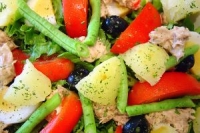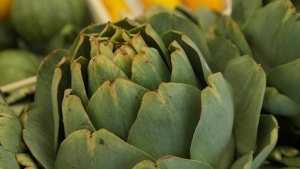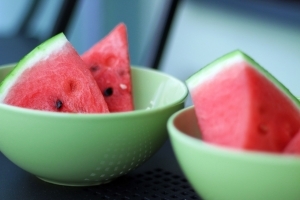Getting Children Cooking
Children are naturally curious and are drawn to the kitchen at an early age. If you encourage them through their messy stage they can become quite competent by around 10 years old and will be able to turn out a handful of recipes.
You'll still need to supervise the use of sharp knives, Gas flames, draining pots of pasta and that sort of thing, but by this age it becomes more of a 'hovering in the background', rather than you actually doing it all. This is the key - you've got to let them make mistakes in order for them to learn, and they've got to be given some responsibility so they can feel that they have made the cake or batch of biscuits, and not you.
Mess, mess, mess! It's hard - just trail around after them wiping up, but teach them little things such as wiping or rinsing their hands before opening the fridge (or the door handle will quickly become sticky), keeping things in from the edge of the bench so they don't fall off, getting all ingredients in order before starting cooking so they don't suddenly discover they haven't got something, or that it needs peeling, grating or chopping.
Most important of all, it's got to be fun, not a chore. And give them heaps of praise. Remember, that little boy or girl turning out a misshapen biscuit today could become a master chef with a little encouragement from you, and then you'll be the one to reap the rewards!
Baking is a great place to start. Because most children love sweet things.
There's no reason why a young cook can't have a success with a home-baked cake.
There are basically four different methods of making cakes:
- Rubbing in method - where butter is rubbed into flour, as for scones;
- Whisking method - where eggs and sugar are whisked together, as for a sponge cake;
- Creaming method - where butter and sugar are creamed together, eggs are mixed in, then the dry ingredients - used for many cakes, biscuits and puddings;
- Warming method - where butter, sugar and other ingredients are melted together, and folded together with dry ingredients, as in gingerbread.
Best-ever Blueberry Muffins
Muffins are incredibly popular in New Zealand. I think it must be because they are relatively easy to make and quick to cook (more weighing and measuring than anything else; just the thing that kids will enjoy making).
These are my favourite muffins of all time.
Ingredients
- 1¾ cups plain flour
- ¾ teaspoon salt
- ¼ cup caster sugar
- 2½ teaspoons baking powder
- 2 teaspoons grated lemon zest
- 1¼ cups blueberries
- 1 large egg, at room temperature
- ¾ cup milk
- 1/3 cup light tasteless oil
- little extra melted butter and castor sugar
Method
Sieve the flour, salt, caster sugar and baking powder into a large bowl. Sprinkle over the lemon zest and the blueberries. Beat the egg well then add the milk and oil and mix well together (don't beat as this makes the muffins tough).
Spoon at once into buttered muffin tins or non-stick muffin tins, filling the tins to the top.
Bake in an oven preheated to 225°C for 20 to 25 minutes till risen and golden. Remove from the oven, leave in the tray for 5 minutes, then flip out with a small knife onto a cooling rack.
Meanwhile melt the butter and dip the tops of the muffins into the butter then into a little castor sugar. Serve warm with extra butter, ricotta cheese, sour cream or whipped cream.
Sticky Gingerbread
Ingredients
- 330g plain flour
- 1 heaped teaspoon ground ginger
- ¼ teaspoon salt
- 1 teaspoon baking powder
- 50g preserved ginger, chopped (optional)
- 170g brown sugar
- 125g butter
- 75g golden syrup
- 120g black treacle
- 1 egg
- 300ml milk
- 1 teaspoon bicarbonate of soda dissolved in a little milk
Method
Sift the dry ingredients into a large bowl, and stir in the preserved ginger. Warm the sugar, butter, golden syrup and black treacle in a small pan until dissolved; don't boil.
Beat the egg and milk together. Combine all the ingredients, including the bicarbonate of soda dissolved in a little of the milk; mix together until combined but don't beat.
Pour into a nonstick loaf tin (23cm long x 12-13cm wide x 7cm deep) lined with baking paper on the bottom. Bake in an oven preheated to 175°C (regular) for 1 1/2 hours. If the top starts to colour too quickly, drape a piece of aluminium foil loosely over the surface to deflect the heat. Cool in the tin for 10 minutes, then turn onto a cooling rack.
Gingerbread tips
Gingerbread is made using the warming method (the fats and sugars are warmed to combine them), which is one of the easier cake-making methods. Make sure the ground ginger you use is fresh. Ground spices have a short shelf-life. Every few months it is worth going through the pantry and throwing out unused spices because all they're doing is sitting there spoiling and going musty.
The gingerbread is at its sticky best on day three of its life. It's very good on day four. On day five it's still okay, and it's not bad on day six, and it's still edible on day seven. There's not that many cakes that keep as well.
Getting started
Wash and dry hands before starting cooking.
Read through the recipe so you can anticipate each stage.
Put the oven on before you start, as some recipes, especially if made with baking powder, need to go in the oven immediately after mixing (the baking powder is activated by liquid).
Prepare any tins, trays or dishes required.
There is much controversy over measuring devices - cups and spoons are easier - but when it comes to baking, scales ensure accuracy.
Cake tin tips
Lining a cake tin makes it easier to turn the cake out, and it also offers some protection to the sides and bottom of the cake as it cooks. Baking paper is ideal to line cake tins because it is non-stick.
Cut a round piece for the bottom, tracing the shape of the tin onto the paper using a pencil, and cut it just slightly inside the pencil line with scissors. Cut a wide band long enough to go around the sides of the tin; this band of paper should be marginally higher than the cake tin, so that once it is folded, it is the same height as the tin.
Fold over one edge of the paper then snip it with scissors about every centimeter or so. This helps it fit around the inside of the cake tin. Put the band of paper in the tin, with the sniped edge on the bottom of the tin, then put the round of paper on top of the snipped edge.
To keep the paper in place on the bottom of the cake tin, first put a dab or two of the cake mixture underneath the paper to help it stick to the tin. Use another dab of cake mixture to stick the paper around the sides together. Spoon the cake mixture into the tin, putting it in the centre of the tin first and spreading it to the sides without disturbing the paper lining.


